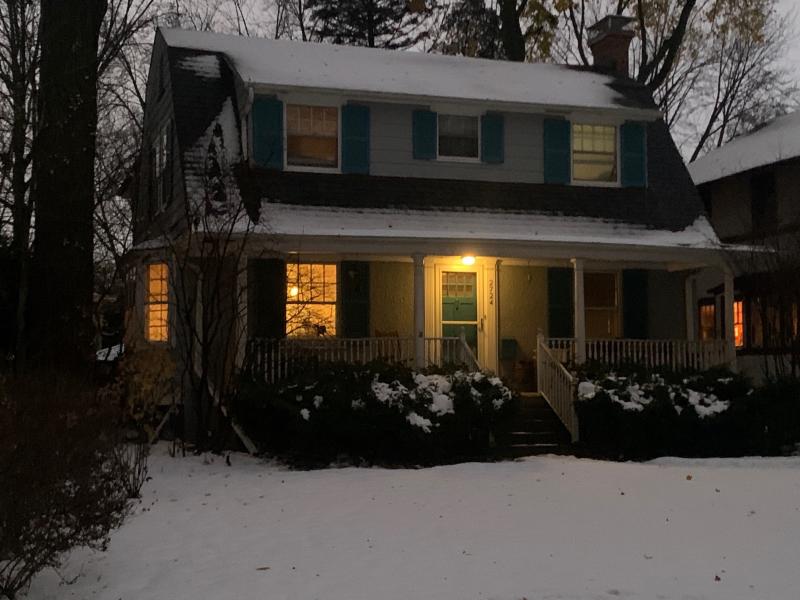Respect the Popularity of the Single-Family Home

Two things stand out in the current zeal of some in Evanston, Illinois to villainize if not obsolete the single-family neighborhood. One is the misplaced blame. In Evanston, single-family homes are an atypical (for the suburbs) minority, albeit a key part of the community. So these dwellings don't drive the market, they reflect it. The other is the complete disregard for the popularity of single-family houses. Overlooking that shows disrespect for quaint notions like choice, freedom, empowerment, and personal space. Right: The author's 2200-sf Dutch Colonial of 34 years, built 1922-23.
First, to make single-family homes the scapegoat for an Evanston where land values have soared while thousands of multi-unit units were added over the past 20 years is, on its face, perverse. Regional planners estimate that of Evanston's roughly 34,000 housing units, at most 31.8% are detached single-family homes, and another 5.0%, are “single-family attached,” i.e., duplexes, townhouses, or rowhouses.1 Those are CMAP figures, using the Census Bureau’s 2018-2022 five-year estimate which tends to lag. The Census Bureau itself in its one-year estimate for 2022 is that 30.7% of Evanston's housing units are detached single-family homes, and another 5.8% were single-family attached2 (i.e., duplexes, townhouses, or rowhouses) which technically are also single-family homes, tho most people mean the detached variety when they speak of SFH. But regardless of whether the 5-year or 1-year estimate is used, close to 2/3 of all Evanston housing units are already in multi-unit buildings. This is a direct result of what the 1972 comprehensive plan described as midcentury "overzoning for apartments." Contrary to revisionist narrative, and despite city leaders' wishes a century ago to promote home ownership as the ideal, Evanston's development has been driven for a long time by the motive to profit off tenants. Very few additional new SFHs were built after the 1970s. The last large groupings were the redevelopment of the former Kendall College campus into a small, fairly dense urban subdivision of 19 single-family lots a decade ago, and the 2006-2016 redevelopment (in three phases, with intermittent financing problems) of the former Hines Lumber property into the 31-unit Church St. Village townhome project.
Evanston’s historic build-up (and increasing) proportion of multi-unit housing is already considerably above county or regional averages. In the larger metro region, by contrast, single-family at 57.3% is a clear majority of housing units, with single-family-detached accounting for 87% of that majority; i.e., about half of all housing.
However, bear in mind how much that understates: Chicago metro figures are skewed by the enormous density of the condos and apartments of Chicago plus a few atypical suburbs like Evanston. Get outside the Big City, and it's clearer how freakishly far from the norm Evanston already is. This leads to the second point, almost completely overlooked in current planning: Americans overwhelmingly want single-family houses.
If home preferences were an election, the single-family home would win the USA by a landslide. A single-family detached home is the choice of, conservatively, 67% of Americans looking to buy homes, and this is true across racial and ethnic groups.3 A Redfin survey found that 90% of millennials, like the vast majority of Americans surveyed, would prefer a single-family home to a home in a triplex.4 Even among American renters, an equal amount live in free-standing houses as in apartments,5 and that trend is growing, though not necessarily by choice.6 Preference for one’s own space is stronger in the Midwest than on the coasts; only in the Northeast of the U.S. do a majority of people live in multi-unit housing, and, not coincidentally, that is where population density is highest and housing is extremely expensive, so the vertical stacking of New Yorkers and New Englanders is not entirely by choice.
Since before WWII, the trend has been to move to metropolitan areas, but most Americans don't want to live shoulder-to-shoulder in block housing with shared walls, nor on postage-stamp lots; 7 out of 10 Americans live in suburban areas, rural areas, or small towns.7 This tendency, if anything, increased during the pandemic.8 The pandemic and its attendant limits on freedom stimulated an even greater preference for larger houses and lots, with more space between people.9 Policymakers should realize the inconsistency of, for three years, telling people to “social distance,” then expecting them to want to cram together. Not coincidentally, the first mass adoption, by municipalities, of zoning codes limiting density, and promoting “light and air,” came on the heels of the “Spanish flu” pandemic of a century ago. So it's neither coincidence nor conspiracy that for every year of the last 55,10 SFHs have made up around 70%-80% of all newly constructed units; that's simply the industry responding to how millions of families want to live, and what buyers want to buy.
Between high school and my purchase in Evanston, I lived for 16 years in various forms of multi-unit housing, from dorms to large apartment complexes to three-flats. Absolutely, such housing fills need at certain stages in life, or is the preference for many. I cherish many of my former neighbors and roommates, and am grateful for the budget that those shared or stacked spaces allowed me to live on. But it's just plain fact that given the choice, most Americans -- not all, but most -- aspire to more. The desire for personal control of space and access to at least a small amount of land on which to garden or play, without having to answer to a landlord or condo association, was and is a powerful driving market force in housing, if not our form of democracy itself. Home ownership is one of the last remaining American asset classes11 that has not been concentrated in the hands of the few.
Cries that Evanston needs to be “welcoming” and ”inclusive” pervade the current push for upzoning in Evanston, but the city's atypical dominance by multi-unit housing is actually already unwelcoming to the average American or Illinoisan. Development drives up land values, pricing the relatively fixed supply of single-family homes out of reach of a market hungry for the privacy and space such homes offer amidst the unique amenities of Evanston. The city should not pursue a policy of even greater hostility to its single-family homeowners, a minority as important as all others. Besides being shortsighted, it's the opposite of inclusionary.
References:
- CMAP, Evanston Community Data Snapshot (July 2024), at 15, https://cmap.illinois.gov/wp-content/uploads/dlm_uploads/Evanston.pdf. A more detailed review of housing constructed since the last detailed survey indicates that single-family-detached houses are probably less than 30% of all housing units. See Jeffrey P. Smith, "Evanston literally doesn’t know what it’s doing," Evanston Roundtable (Feb. 23, 2025)
- US Census Bureau, “QuickFacts | Evanston city, Illinois,” July 2023, https://www.census.gov/quickfacts/geo/chart/evanstoncityillinois/PST045221; see also 2023 Census Quickfacts, https://www.census.gov/quickfacts/geo/chart/evanstoncityillinois/HSD410222. Note discrepancy between CMAP and census estimates.
- Rose Quint, "What Home Buyers Really Want," Nat. Assn. of Home Builders Special Study for Housing Econ. (Mar. 2021), https://www.nahb.org/-/media/NAHB/news-and-economics/docs/housing-econom...
- “89% of homebuyers would prefer a single-family home with a backyard over a unit in a triplex with a shorter commute….Ninety-three percent of millennials would choose a single-family home, as would the vast majority of all other age groups over 25.” Dana Anderson, "Millennials Still Want Single-Family Homes, Even if it Means a Long Commute," Redfin News (Nov. 21, 2019, updated Oct. 6, 2020), https://www.redfin.com/news/millennial-homebuyers-prefer-single-family-h...
- Alana Stramowski, "Which Housing Type Do Renters Prefer?," Avail (Dec. 21, 2022),
https://www.avail.co/education/guides/moving-day-around-the-country/pref... - Debra Kamin, "The Market for Single-Family Rentals Grows as Homeownership Wanes," N.Y. Times (Oct. 22, 2021), https://www.nytimes.com/2021/10/22/realestate/single-family-rentals.html
- “The population of American adults of all ages is distributed fairly equally between cities (28%), suburban areas (37%), and small towns or rural areas (33%).” Joanne Binette, "Where We Live, Where We Age: Trends in Home and Community Preference," AARP Research (Nov. 2021), https://www.aarp.org/research/topics/community/info-2021/2021-home-commu...
- Kim Parker, Juliana Menasce Horowitz, & Rachel Minkin, "Americans Are Less Likely Than Before COVID-19 To Want To Live in Cities, More Likely To Prefer Suburbs," Pew Research Center (Dec. 16, 2021), https://www.pewresearch.org/social-trends/2021/12/16/americans-are-less-...
- Quint, supra n.3.; see also Vianney Goméz, "More Americans now say they prefer a community with big houses, even if local amenities are farther away," Pew Research Center (Aug. 26, 2021), https://www.pewresearch.org/short-reads/2021/08/26/more-americans-now-sa...
- U.S. Census Bureau, “New Privately Owned Housing Units Completed,” https://www.census.gov/construction/nrc/xls/co_cust.xls [1968-2023 data]. Data is for privately-owned new units only.
- "Home ownership is a crucial means of wealth accumulation and serves as a measure of financial security, especially for low- and moderate-income households (Turner and Luea 2009; Goodman and Mayer 2018)." Tamara L. Sheldon & Crystal Zhan, "The Impact of Natural Disasters on US Home Ownership," J. Assn. Enviro. & Res. Economists 2019 6:6, 1169-1203, viewable at https://www.journals.uchicago.edu/doi/epdf/10.1086/705398
- Printer-friendly version
- Log in to post comments
